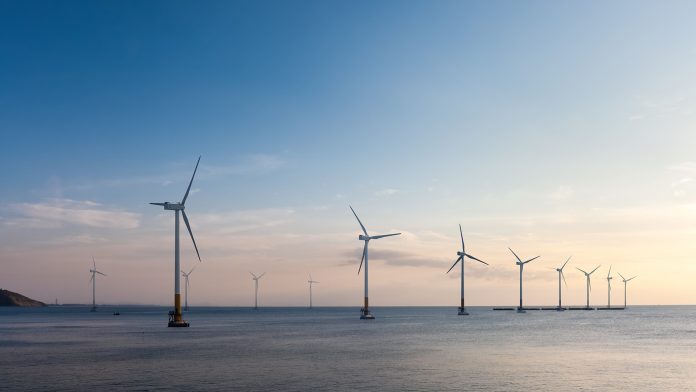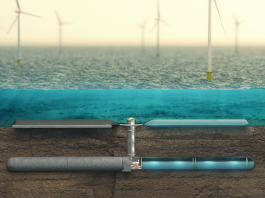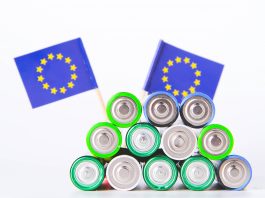The Innovation Platform interviewed Frits Bliek of Ocean Grazer to discuss the issues of balancing energy supply and demand and how ocean batteries may be the solution.
Although there are plenty of green energy products, congestion on electric grids means that much of this green energy is going to waste and causing energy prices to plummet. Matt Brundrett interviewed Frits Bliek of Ocean Grazer to discuss the potential of energy storage to combat energy supply and demand issues.
What are the current issues regarding energy supply and demand?
The energy supply 20 years ago was dominated by direct conditions and not determined by the effects of demand. Somebody switched on a light bulb and noticed more load on the system. In response, they increased power generation. Now, you need something to make sure that you match supply and demand; otherwise, the frequency runs up, as does the voltage on the network. The second effect is that by adding in more renewable generation, you also replace conventional generation units, especially gas-fired power plants, which are used to balance the power system and demand. You are increasing supply volatility by using intermittent power sources and removing the assets that could compensate for that.
On 13 May 2023 energy prices became negative all across Europe for the first time, due to a tremendous oversupply of wind and solar power. There is no offshoot for the power; we need to leave that energy somewhere.
That’s where energy storage comes in. Often, there is no more room in the power grid to transport the energy from the generator to the customer. For example, in the UK, 15% of the wind power being generated is already curtailed due to network congestion and a mismatch in supply and demand. These green electrons never reach their customers, as there is no room for them on the grid. We build more and more renewable generation assets, and they all keep peaking simultaneously. To combat this, storage capacity is needed to move the generation peaks towards the demand peaks, and prevent grid overloading. By adding storage capacity, wind operators can benefit from the price differences and significantly improve the revenues of their wind farms.

Hourly price fluctuations in energy supply and demand reflect the changes in over and under supply. Profit can be maximised by trading on the day-ahead and intraday energy markets, and even more value can be gained by trading on the balancing markets. You need deep and long-lasting storage installations that can handle these fluctuations. To maximise profit, a storage system needs to be able to handle 1,500 – 10,000 cycles per year, depending on the revenue model and local market conditions.
Therefore, you need deep energy storage to shift the energy over multiple hours. You need to go beyond the current barriers (typical storage systems available now have a storage depth of one to four hours) to depths that can shift eight or 12 hours. That is where the Ocean Grazer ocean battery has a lot of value. The technology is based on mature pumped hydro storage technology that can provide over a million cycles, meaning you can frequently dispatch a system without ageing the technology and effectively use any price fluctuation.
The ocean battery also allows you to build a system where the power capacity, defining how fast you can absorb a peak, operates independently of the storage depth or how much energy you can store. The electro-chemical battery technologies on the market have limited flexibility in choosing the ratio between power and storage capacity, making it difficult to build a system where you have a good balance between the power capacity and the storage volume, limiting the profitability of these systems. The modular nature of the Ocean Battery allows free configuration of the power capacity and the storage depth, allowing for the minimisation of the system’s CAPEX, and maximising the net present value of the project.
How is Ocean Grazer addressing these challenges?
What we do to combat energy supply and demand issues can be seen using a typical hydro storage installation as an example. These use a large vessel in the upper mountains and run the water flow to a hydro turbine. With a hydro dam alone, the river takes the discharged water away. But if you want to use it for storage and you have excess power, you can start pumping up the water again, up to a higher reservoir, and you build a closed loop, which is quite efficient with a proficiency of roughly 80%. However, mountains are required for this to be feasible. And that’s especially difficult when you have a grid congestion problem because they are very localised, not always near mountains. For example, you can’t take more cars onto the highway if they’re already in a traffic jam. The same applies to energy on a power grid. It must be resolved at the point where the ‘traffic jam’ is and limit the flow of energy with effective storage systems.
We transform known technology into something that takes this concept and applies it on a smaller, localised scale, for example, into the seabed. We have large bags on the seabed, which we fill with water, which then flows (like the water in the upper reservoir of a dam) down to a chamber where the turbines are installed. Large rigid reservoirs are installed in the seabed, where the water is then captured. That is where you effectively build an identical system to a traditional hydro storage system, except now you can build it almost anywhere. We started off at sea, as pressurised water is available for free on the seabed, without needing to first build a hydrodam. The pumps and the turbines are highly reliable, typically lasting for 50 years or more, and are made from abundantly available materials, meaning no resource limit.
There is the potential for a large part to be constructed by local people, for example, building the reservoirs out of concrete, creating local jobs and benefitting local businesses and resources. Sharing that profit is quite a smart solution to handle these challenges.
The Ocean Battery can take over a million cycles, there is no degradation in capacity, as with traditional batteries, and there’s no self-discharge; if the power leaks away in the storage system, it’s costly. With these systems, as soon as you close the valves, the energy stays there until you unleash the potential energy again and start generating power. The high number of cycles helps balance supply and demand, resulting in the lowest levelised cost of storage possible for every cycle because the system just lasts. Investment costs can be spread out over a very long time, so we can scale up to almost any size by just adding more underground reservoirs. You can build the system as deep as you like, considering the balance between your capital expenditure and the revenue you generate.
How important is energy storage, and can you provide examples of when you’ve demonstrated this importance?
We have ever-increasing plans to build new renewable assets. And as I discussed earlier, we have seen that the market prices are going negative over Europe. It shows that it’s something that increasingly impacts the system’s stability. There are a lot of issues, especially with integrating solar power, where you have a huge peak around noon, and grid operators are limiting the capacity of the connections to 50% of the peak just to ensure that the load going into the system isn’t too much. At the same time, it also means that the operators of those PV solar plants need to be able to offload that peak somehow.
We considered their projects, a large industrial installation combined with solar plants. Depending on the location, you could also have cogeneration with a wind farm. If you add up those profiles, you can reach for an upper level of local generation by adding a battery. This has two advantages: The installation operator gets almost 100% renewable energy, and you can also fix the energy prices.
Over the last few years, we have learned that price fluctuations can have a huge impact on our economy and the profitability of companies. By combining storage with local generation, companies can become more independent from the energy market. Although there is usually a great connection available, in most cases, what we also see in some cases is that it’s tough to get a good connection. In those cases, if you combine the local generation with storage assets, you will get more than what you would get if you just operated the renewable generation assets and connected them to the grid.
Many renewable energy projects are waiting for the grid operator to provide capacity. However, if you can start building your energy storage assets parallel to your generation assets, then that dependency on grid capacity decreases. Many of these renewable energy projects are suffering by waiting for the time they will have good capacity; being unable to inject the power into the grid is a huge bleeder for most project developers. Adding storage assets makes it much easier to start building your projects, getting reasonable revenues during times of bad connection, and then expanding afterwards, ensuring you further optimise the system’s profitability. It’s a new way of looking at developing projects and adding value to them. We can build with both new projects and existing installations for increased profitability. On average, this leads to payback times of six to eight years, depending on the business case.
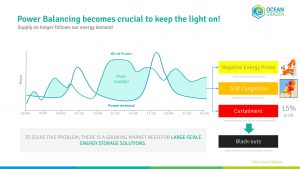
How does Ocean Grazer plan to scale up energy storage solutions whilst maintaining eco-friendliness and resource sustainability?
The system’s scalability mainly comes from the reservoirs underground. You can add more reservoirs under the seabed, meaning you can keep expanding those capacities after installation. We think it’s a very important capability because the market will look quite different 20 years from now. In financial terms, this means there is an increasing drive to have more capacity to profit from fluctuations and keep the system stable.
In terms of eco-friendliness, we use abundantly available materials. By using local resources to build our systems, we can also quickly start expanding because our view on the market is that building a sufficient production capacity is crucial. For example, look at offshore wind farms. Many of the issues today arise because increasing the production capacity or building more wind turbines is difficult, and the offshore market is huge. And with plans to expand globally beyond 12,000 gigawatts (roughly the size of the entire generation capacity of Europe), stepping into that market means you should have a supply chain that can provide the capacity to support a connection for all those wind farms. And that requires smarter usage of local capacities that you can use to build those reservoirs and make that process as simple as possible to install.
We also have a completely modular system, meaning people can effectively pick and choose their capacities and define the system for themselves. We can then install the same units in almost any location to scale it up. It is an effective, simple concept where all the complexity of designing and handling this stuff is not a concern for the project’s developers. In the future, we expect to have an online platform whereby people can define the system they require, resulting in an energy storage system that will work for them and present all the resulting investments they will need to support that project. Then, the entire supply chain can effectively start from there. Offshore project developers and consultancies can start developing the projects without a huge interaction and are mostly done on the online platform. They can start building their project quickly.
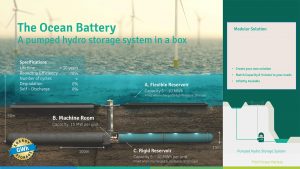
How do ocean batteries synergise with existing energy storage solutions, and what benefits do they offer?
The most promising combination so far has been with hydrogen production. The electrolyser presents huge opportunities to produce green energy. It’s also very attractive for certain industrial installations to combine an electrolyser with local generation from wind and solar. If you combine them properly with an Ocean Battery system, you can increase the amount of locally generated green hydrogen significantly.
It also makes a great combination if the developers of a project intend to use green energy entirely in their own process, using that excess green energy instead of effectively burning coal to get the electrolyser burning. Looking at the business case, it has been a profitable combination since we add more value to the electrolyser by generating more green hydrogen. At the same time, the excess of green electrons being generated is then being used and not curtailed or sold off for low prices. By having storage in between, you allow all the excess green energy to go to the electrolyser or wait for a higher price.
Electrolysers must run a utilisation factor between 70% and 90% to maintain efficiency. When powering your own energy storage systems, you just can’t guarantee that without energy storage. With energy storage in mind, you can start building projects with a plan, taking the storage facility into account and, in combination with the local generation and implementing ocean batteries. We see that as a pathway to bringing green energy to the European Union and balancing energy supply and demand.
Please note, this article will also appear in the sixteenth edition of our quarterly publication.

